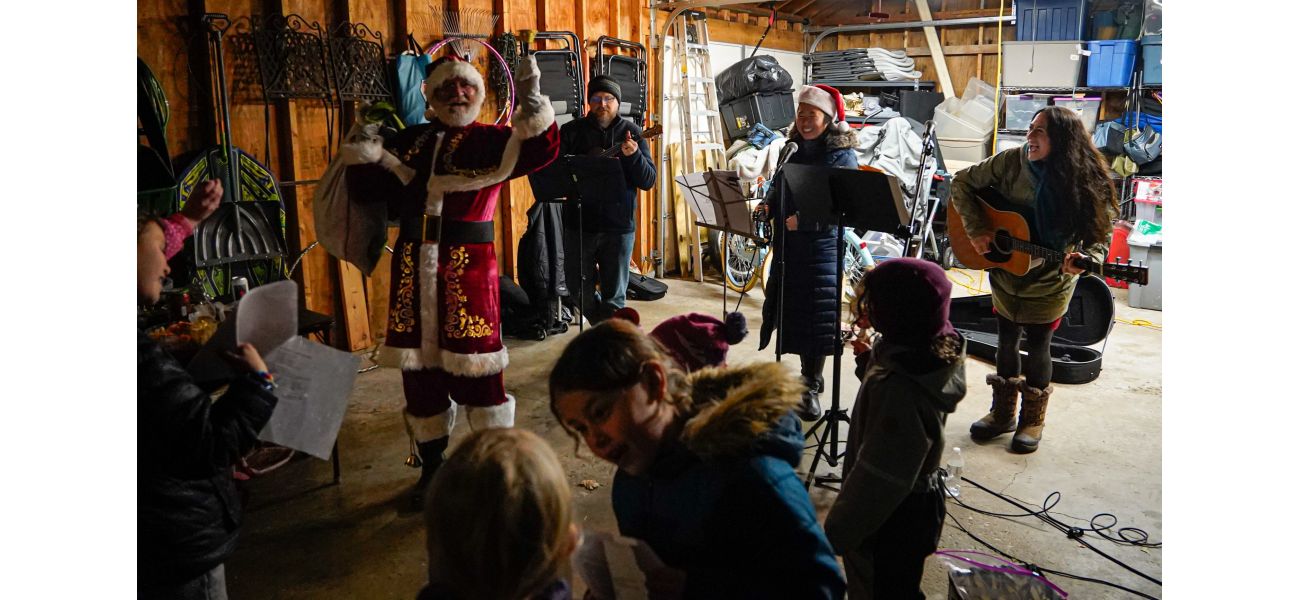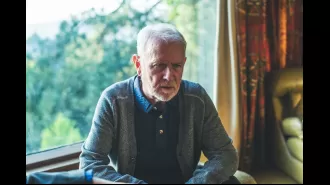Families in Chicago with mixed religious backgrounds use Christmas and Hanukkah as an opportunity to discover different customs.
Hanukkah and Christmas coinciding can make for a more blended celebration for families with both traditions.
December 25th 2024.

Peter Kujawinski was thrilled with the new twist he had added to his family's long-standing tradition of wearing matching Christmas pajamas. This year, he had a surprise in store for everyone. "I haven't told anyone yet," he said with a grin. "But I ordered Hanukkah pajamas because, let's face it, when Hanukkah falls on the same day as Christmas, you have to take advantage of it."
Growing up, Peter, now 50, was raised Roman Catholic, while his wife Nancy, 47, was brought up in a Reform Jewish family. As Hanukkah and Christmas now overlapped, their two sets of traditions were even more intertwined. The couple and their three children, who live in Lincoln Square, were part of a growing trend in America - families belonging to more than one religion. The number of interfaith marriages has risen, particularly among American Jews. In fact, a study found that 42% of U.S. Jews were married to non-Jewish partners, with 61% of those marriages taking place since 2010.
For these families, the holiday season can be a challenge in terms of navigating between different religious traditions. However, Samira Mehta, a scholar at the University of Colorado Boulder, believes that most interfaith couples enter their relationships with a deep respect for each other's beliefs. This respect is reflected in how they choose to celebrate holidays, not just in December, but throughout the year. "I truly believe that what matters is not what an individual interfaith family decides to do, but how they make that decision with respect and understanding," she said.
The Kujawinski family had found a way to blend their two religions into a harmonious holiday season. They started with a traditional Polish fish dinner and Oplatki, Christmas wafers, on Christmas Eve. On Christmas Day, they would light the first candle of their menorah. Nancy was also planning to make latkes, although she joked that she hoped she wouldn't burn them and smoke out the kitchen.
Peter acknowledged that navigating between two religions could be challenging, but he believed that combining and creating traditions brought a lot of joy to their family. This sentiment was shared by other interfaith couples, including the Kaplans. Andrew, 32, recalled his first Mass with Natalia's family, where he was unsure of the proper etiquette for someone who wouldn't take communion. The couple, who were married by both a priest and a rabbi, were raising their son with both sets of holidays, traditions, and religious education. They even attended a couples' dialogue group at a dual-religion school.
Natalia, 32, admitted that if she had married someone from the same religion, faith might not have played such a significant role in her life. "Being married to Andy has made me put more effort and intention behind my religious practices and traditions," she said. Andrew added that being in an interfaith relationship had strengthened his connection to Judaism and led to more introspection.
For the Weinsteins, Christmas and Hanukkah were celebrated in typical ways, such as attending a performance of "The Nutcracker" and hosting a Hanukkah party. However, they also volunteered on Christmas morning at a food pantry, along with families from both the Kenwood synagogue KAM Isaiah Israel and Old St. Mary's School. Lainey, 54, believed that this tradition was rooted in both religions' values of service and repairing the world. The family focused on finding shared morals and ethics in their religious lives, rather than getting caught up in theological differences. "We find community in both faiths," Lainey said.
In Steve Hunter's house, Judaism was the primary religion, but his Christian wife also played a significant role in their family's spiritual life. "It's a Jewish home with a Christian living in it," Steve joked. Their children were raised in the Jewish faith, but they also celebrated Christmas with their extended family. This blending of traditions was a natural part of their family life, and they didn't see it as a conflict. "We don't focus on the differences, but on the shared values and sense of community," Steve said.
Peter Kujawinski is thrilled with the new twist he has brought to his family's holiday tradition this year. As he proudly shares, "I haven't told anyone yet, but I ordered Hanukkah pajamas because you have to take advantage of the fact that it falls on the same day as Christmas."
Growing up with a Roman Catholic background, Peter, now 50, and his wife Nancy, who was raised in a Reform Jewish family, have always had a blend of traditions in their household. However, with Hanukkah coinciding with Christmas this year, their already intertwined traditions will be even closer in proximity.
The Kujawinski family, who resides in Lincoln Square, is part of a growing trend in America where families belong to more than one religion. This rise in intermarriage is especially prominent among Jewish families, with a Pew Research survey revealing that 42% of American Jews are married to partners of different faiths, and 61% of those marriages have occurred since 2010.
According to scholar Samira Mehta, who specializes in interfaith family life, navigating the holidays can be a challenge for families with multiple religions. However, she also notes that most couples in interfaith marriages enter into their relationships with mutual respect for each other's traditions. This respect is evident in the way they choose to celebrate holidays, not just in December, but throughout the year.
As Mehta explains, "I don't think it matters what any individual interfaith family decides to do. What matters is that they make the decision in a way that is respectful." For the Kujawinskis, this means taking an all-inclusive approach to their holiday celebrations. They will start with a traditional Polish fish dinner and Oplatki (Christmas wafers) on Christmas Eve and end the day by lighting the first candle of their menorah. Nancy, 47, is also planning to make some latkes, although she jokes, "As long as I don't burn them and smoke out the kitchen!"
Peter adds that while combining and creating traditions can be challenging, it also brings a lot of joy. This sentiment is shared by other interfaith families, such as the Kaplans. Andrew, 32, recalls his first experience attending Mass with his future wife's family and feeling lost as to what to do during communion. He says, "I just kind of laid on the bench and let people walk by because I didn't know where to go. I think Natalia was mortified. I just had no idea."
But for the Kaplans, most of their efforts to merge their Roman Catholic and Reform Jewish backgrounds have been much smoother. They were married by both a priest and a rabbi and attend a couples' dialogue group at a dual-religion school. They are also raising their son with both sets of holidays, traditional foods, and religious education from both backgrounds.
This year, they will celebrate Christmas Eve and Christmas Day with Natalia's family, followed by a visit to her side of the family for dinner, caroling, and Mass. Natalia, 32, shares that marrying someone of a different faith has made her appreciate her own faith more. She says, "The fact that I married Andy means I have had to put more effort and intention behind my religious practices and traditions. He asks questions like, 'What does this mean?' or 'Why are you doing this?' which leads to more introspection." Andrew agrees, adding, "Being in an interfaith relationship has strengthened my relationship with Judaism."
For Lainey Weinstein and her family, Christmas and Hanukkah are celebrated in many traditional ways, but their focus is on finding shared morals and ethics rather than theology. As Lainey, 54, explains, "I don't know if God really drives this. I find community in both faiths, and my family finds community in both faiths."
Similarly, Steve Hunter and his family also prioritize shared morals and ethics in their religious lives rather than theology. As Steve puts it, his house is "a Jewish home with a Christian living in it." This approach allows his family to find a sense of community in both faiths and come together in service and repairing the world. As they volunteer at the St. James Food Pantry on Christmas morning, they are joined by families from their synagogue and their daughters' former Catholic school.
In the end, the holidays may present tricky choices for interfaith families, but it is their mutual respect, shared values, and sense of community that allows them to navigate through any challenges and create their own unique traditions. As Peter Kujawinski aptly puts it, "We think of maneuvering between two religions as something that is difficult or a challenge, but there is also a lot of joy in combining and creating traditions."
Growing up, Peter, now 50, was raised Roman Catholic, while his wife Nancy, 47, was brought up in a Reform Jewish family. As Hanukkah and Christmas now overlapped, their two sets of traditions were even more intertwined. The couple and their three children, who live in Lincoln Square, were part of a growing trend in America - families belonging to more than one religion. The number of interfaith marriages has risen, particularly among American Jews. In fact, a study found that 42% of U.S. Jews were married to non-Jewish partners, with 61% of those marriages taking place since 2010.
For these families, the holiday season can be a challenge in terms of navigating between different religious traditions. However, Samira Mehta, a scholar at the University of Colorado Boulder, believes that most interfaith couples enter their relationships with a deep respect for each other's beliefs. This respect is reflected in how they choose to celebrate holidays, not just in December, but throughout the year. "I truly believe that what matters is not what an individual interfaith family decides to do, but how they make that decision with respect and understanding," she said.
The Kujawinski family had found a way to blend their two religions into a harmonious holiday season. They started with a traditional Polish fish dinner and Oplatki, Christmas wafers, on Christmas Eve. On Christmas Day, they would light the first candle of their menorah. Nancy was also planning to make latkes, although she joked that she hoped she wouldn't burn them and smoke out the kitchen.
Peter acknowledged that navigating between two religions could be challenging, but he believed that combining and creating traditions brought a lot of joy to their family. This sentiment was shared by other interfaith couples, including the Kaplans. Andrew, 32, recalled his first Mass with Natalia's family, where he was unsure of the proper etiquette for someone who wouldn't take communion. The couple, who were married by both a priest and a rabbi, were raising their son with both sets of holidays, traditions, and religious education. They even attended a couples' dialogue group at a dual-religion school.
Natalia, 32, admitted that if she had married someone from the same religion, faith might not have played such a significant role in her life. "Being married to Andy has made me put more effort and intention behind my religious practices and traditions," she said. Andrew added that being in an interfaith relationship had strengthened his connection to Judaism and led to more introspection.
For the Weinsteins, Christmas and Hanukkah were celebrated in typical ways, such as attending a performance of "The Nutcracker" and hosting a Hanukkah party. However, they also volunteered on Christmas morning at a food pantry, along with families from both the Kenwood synagogue KAM Isaiah Israel and Old St. Mary's School. Lainey, 54, believed that this tradition was rooted in both religions' values of service and repairing the world. The family focused on finding shared morals and ethics in their religious lives, rather than getting caught up in theological differences. "We find community in both faiths," Lainey said.
In Steve Hunter's house, Judaism was the primary religion, but his Christian wife also played a significant role in their family's spiritual life. "It's a Jewish home with a Christian living in it," Steve joked. Their children were raised in the Jewish faith, but they also celebrated Christmas with their extended family. This blending of traditions was a natural part of their family life, and they didn't see it as a conflict. "We don't focus on the differences, but on the shared values and sense of community," Steve said.
Peter Kujawinski is thrilled with the new twist he has brought to his family's holiday tradition this year. As he proudly shares, "I haven't told anyone yet, but I ordered Hanukkah pajamas because you have to take advantage of the fact that it falls on the same day as Christmas."
Growing up with a Roman Catholic background, Peter, now 50, and his wife Nancy, who was raised in a Reform Jewish family, have always had a blend of traditions in their household. However, with Hanukkah coinciding with Christmas this year, their already intertwined traditions will be even closer in proximity.
The Kujawinski family, who resides in Lincoln Square, is part of a growing trend in America where families belong to more than one religion. This rise in intermarriage is especially prominent among Jewish families, with a Pew Research survey revealing that 42% of American Jews are married to partners of different faiths, and 61% of those marriages have occurred since 2010.
According to scholar Samira Mehta, who specializes in interfaith family life, navigating the holidays can be a challenge for families with multiple religions. However, she also notes that most couples in interfaith marriages enter into their relationships with mutual respect for each other's traditions. This respect is evident in the way they choose to celebrate holidays, not just in December, but throughout the year.
As Mehta explains, "I don't think it matters what any individual interfaith family decides to do. What matters is that they make the decision in a way that is respectful." For the Kujawinskis, this means taking an all-inclusive approach to their holiday celebrations. They will start with a traditional Polish fish dinner and Oplatki (Christmas wafers) on Christmas Eve and end the day by lighting the first candle of their menorah. Nancy, 47, is also planning to make some latkes, although she jokes, "As long as I don't burn them and smoke out the kitchen!"
Peter adds that while combining and creating traditions can be challenging, it also brings a lot of joy. This sentiment is shared by other interfaith families, such as the Kaplans. Andrew, 32, recalls his first experience attending Mass with his future wife's family and feeling lost as to what to do during communion. He says, "I just kind of laid on the bench and let people walk by because I didn't know where to go. I think Natalia was mortified. I just had no idea."
But for the Kaplans, most of their efforts to merge their Roman Catholic and Reform Jewish backgrounds have been much smoother. They were married by both a priest and a rabbi and attend a couples' dialogue group at a dual-religion school. They are also raising their son with both sets of holidays, traditional foods, and religious education from both backgrounds.
This year, they will celebrate Christmas Eve and Christmas Day with Natalia's family, followed by a visit to her side of the family for dinner, caroling, and Mass. Natalia, 32, shares that marrying someone of a different faith has made her appreciate her own faith more. She says, "The fact that I married Andy means I have had to put more effort and intention behind my religious practices and traditions. He asks questions like, 'What does this mean?' or 'Why are you doing this?' which leads to more introspection." Andrew agrees, adding, "Being in an interfaith relationship has strengthened my relationship with Judaism."
For Lainey Weinstein and her family, Christmas and Hanukkah are celebrated in many traditional ways, but their focus is on finding shared morals and ethics rather than theology. As Lainey, 54, explains, "I don't know if God really drives this. I find community in both faiths, and my family finds community in both faiths."
Similarly, Steve Hunter and his family also prioritize shared morals and ethics in their religious lives rather than theology. As Steve puts it, his house is "a Jewish home with a Christian living in it." This approach allows his family to find a sense of community in both faiths and come together in service and repairing the world. As they volunteer at the St. James Food Pantry on Christmas morning, they are joined by families from their synagogue and their daughters' former Catholic school.
In the end, the holidays may present tricky choices for interfaith families, but it is their mutual respect, shared values, and sense of community that allows them to navigate through any challenges and create their own unique traditions. As Peter Kujawinski aptly puts it, "We think of maneuvering between two religions as something that is difficult or a challenge, but there is also a lot of joy in combining and creating traditions."
[This article has been trending online recently and has been generated with AI. Your feed is customized.]
[Generative AI is experimental.]
0
0
Submit Comment





